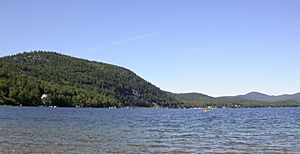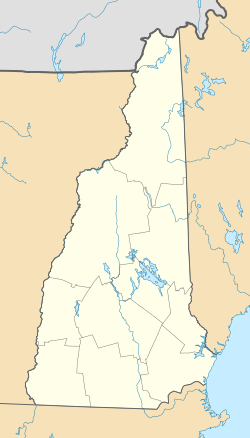Newfound Lake facts for kids
Quick facts for kids Newfound Lake |
|
|---|---|

Newfound Lake from Wellington State Park, Bristol, NH
|
|
| Location | Grafton County, New Hampshire |
| Coordinates | 43°39′46″N 71°46′31″W / 43.66278°N 71.77528°W |
| Primary inflows | Fowler River Cockermouth River |
| Primary outflows | Newfound River |
| Basin countries | United States |
| Max. length | 6.0 miles (9.7 km) |
| Max. width | 2.4 miles (3.9 km) |
| Surface area | 4,451 acres (18.01 km2) |
| Max. depth | 183 feet (56 m) |
| Surface elevation | 588 feet (179 m) |
| Islands | Mayhew Island Wolf Island Cliff Island Belle Island Loon Island |
| Settlements | Bristol Bridgewater Alexandria Hebron |
Newfound Lake is a beautiful lake found in Grafton County, New Hampshire, United States. It's located in the central part of New Hampshire, in an area known as the Lakes Region. The lake touches the towns of Alexandria, Bridgewater, Bristol, and Hebron. Newfound Lake covers about 4,451 acres (18.0 km2). This makes it one of the largest lakes completely within New Hampshire. Only Lake Winnipesaukee and Squam Lake are bigger.
Contents
Exploring Newfound Lake's Geography
Newfound Lake has a shoreline that stretches for about 22 miles (35 km). The lake is roughly 2.5 miles (4.0 km) wide and 6 miles (10 km) long. At its deepest point, the lake goes down 183 feet (56 m). This makes it one of the deepest lakes in New Hampshire.
Rivers Flowing In and Out
Two main rivers flow into Newfound Lake. These are the Fowler River and the Cockermouth River. The water then flows out of the lake through the Newfound River. This river travels through the village of Bristol before joining the Pemigewasset River. The lake holds a huge amount of water, about 98 billion gallons!
Wellington State Park: A Great Place to Visit
Wellington State Park is a large park located on the west side of Newfound Lake. It covers 204-acre (83 ha) in the town of Bristol. This park has the biggest freshwater swimming beach in the New Hampshire state park system. It's a popular spot for swimming and enjoying the lake.
Belle Island: A Gift to the State
Belle Island is a small island located near the southern end of Newfound Lake. In 1942, a boys' camp called Camp Mowglis gave this island to the state of New Hampshire. A special plaque on the island explains why. It says the island was given so it would "remain perpetually in its natural beauty for a camping area." It's meant for everyone to enjoy, especially New Hampshire residents.
Popular Sandbars for Fun
Newfound Lake has a couple of popular sandbars. These are shallow, sandy areas where people can relax. One sandbar is at the mouth of the Fowler River, just south of Wellington State Park. Another is in Hebron, near where the Cockermouth River enters the lake. This one is in the northwest corner of the lake.
What's in a Name? The History of Newfound Lake
The name "Newfound Lake" has an interesting history. Some people believe that Native Americans called the lake "Pasquaney." This name supposedly meant "the place where birch bark for canoes is found."
How the Lake Got Its Current Name
In the 1700s, maps of the area sometimes showed the lake without a name. However, in 1751, explorers John Kendall and Jonathan Farwell called it "Newfound Lake" or "Baker's Pond." Later, in 1766, local records referred to it as "Newfound pond." In 1791, a historian named Jeremy Belknap called it "New Chester Pond." Eventually, the name "Newfound Lake" became the official one. A local poet, Fred Lewis Pattee, even wrote a poem about the lake using its supposed old Indian name, "Pasquaney Lake."
Who Owned the Land Around the Lake?
The land around Newfound Lake was once part of a big argument. Two people, John Mason and Peter Wheelright, both claimed they owned a large area that included the lake.
A Long-Lasting Land Dispute
In 1629, John Mason, a merchant from London, was given land that stretched from Newfound Lake to the Merrimack River in Massachusetts. However, six months earlier, Reverend Peter Wheelright had bought a similar large piece of land from Native Americans. This led to a long legal battle that lasted for over 100 years!
The Land Becomes "New Chester"
Eventually, John Tufton Mason, who was John Mason's descendant, won the case. He then sold the land to a group called the Masonian proprietors. In 1753, a group of people from Chester, New Hampshire bought the land from the Mason proprietors. This area then became known as "New Chester." Later, in 1788, the land was divided. The northern and eastern parts of the lake became the town of Bridgewater. In 1819, two-thirds of the lake became part of the town of Bristol.
Fish Life in Newfound Lake
Newfound Lake is home to many different kinds of fish. People have worked to help the fish populations in the lake for a long time.
Stocking Efforts and Fish Hatcheries
In the late 1800s, people started adding fish to the lake. For example, in 1890, 15,000 landlocked salmon were put into the Fowler River, which flows into the lake. In 1898, 40,000 whitefish from Lake Superior were also added.
To help with this, a fish hatching house was built on the Newfound River in 1889. This building made it easier to collect fish eggs and help them hatch. It could hold many thousands of eggs. Later, a bigger house was built. It could hold over a million lake trout eggs, plus thousands of brook trout and landlocked salmon eggs. To keep the fish in the lake, a screen was built at the lake's outlet. This stopped fish from swimming down the Newfound River.
What Kinds of Fish Live Here Now?
Today, 22 different types of fish live in the Newfound Lake area. Here are some of them:
- Brook trout
- Brown bullhead
- Burbot
- Chain pickerel
- Common shiner
- Creek chub
- Eastern blacknose dace
- Fallfish
- Golden shiner
- Lake trout
- Landlocked salmon
- Longnose dace
- Margined madtom
- Rainbow smelt
- Rainbow trout
- Redbreast sunfish
- Rock bass
- Round whitefish
- Slimy sculpin
- Smallmouth bass
- White sucker
- Yellow perch
Some of these fish, like brook trout and lake trout, are considered very important for a healthy lake ecosystem. This means their presence helps show that the lake is doing well.
Every year, from mid-March to early July, more fish are added to the lake. For example, in 2011, over 300 landlocked salmon and more than 1,800 rainbow trout were stocked in Newfound Lake.
Steamboats on Newfound Lake
For many years, steamboats traveled across the waters of Newfound Lake. These boats were an important way to get around and carry goods.
Early Steamboats and Their Fates
The first steamboat on the lake was called the Pioneer. It was launched in 1865 but was later destroyed by fire. In 1878, another steamboat, the 56-foot (17 m) Cardigan, began operating. It sailed until 1883. That same year, a smaller boat called the Lady Helen joined it, but it also burned down. In May 1900, the Stella-Marion was launched. This boat carried mail and passengers until it was destroyed by fire in 1915.
Lighthouses of Newfound Lake
Even though it's a lake, Newfound Lake has lighthouses! These structures help guide boats.
Reed Lighthouse was built in 1932. It stands on West Shore Road, near an area called the Ledges. Newfound Lighthouse is located at the Paradise Point Lodge on Route 3A in Bridgewater.
Protecting Newfound Lake
Many people care about keeping Newfound Lake clean and healthy. The Newfound Lake Region Association (NLRA) was started in 1971 to help protect the lake's waters and the land around it. Thanks to these efforts, a large amount of land, about 6,653 acres (2,692 ha), is now protected. This means it will stay natural and beautiful for future generations.
Images for kids




